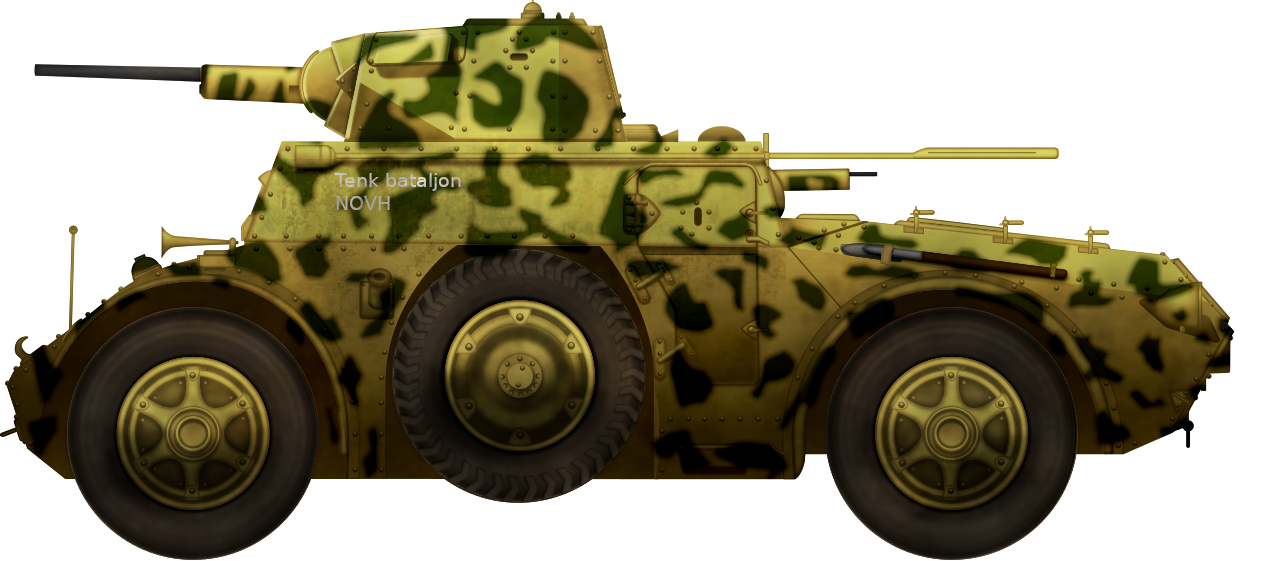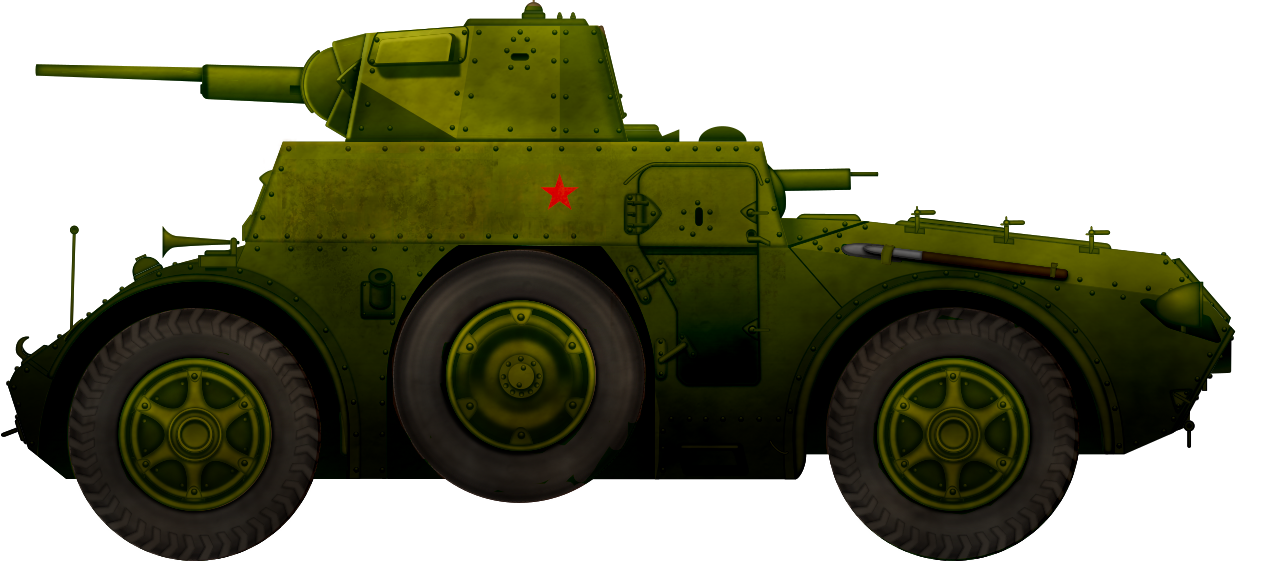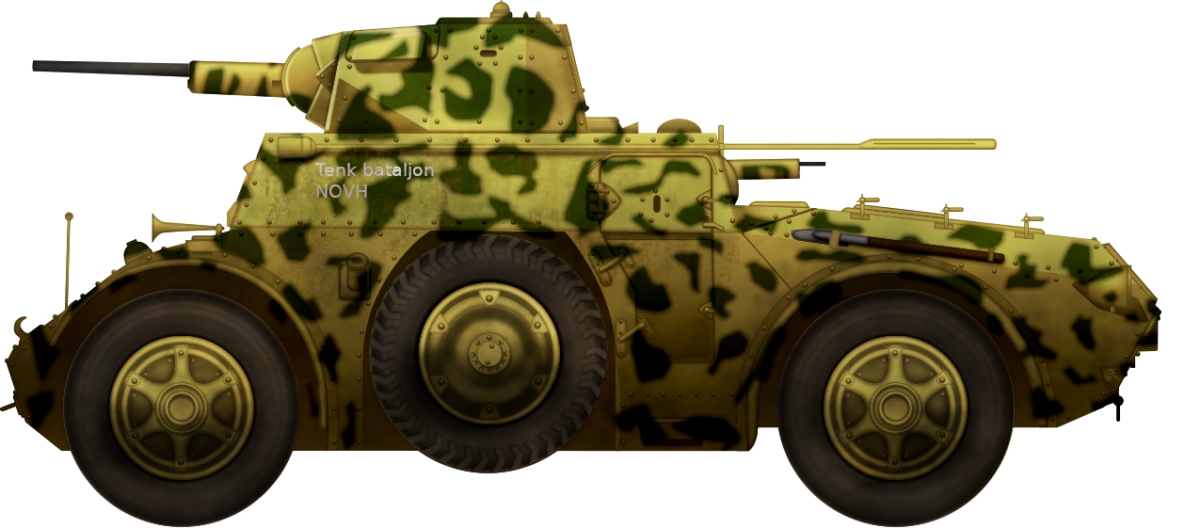
 Yugoslav Partisans/Socialist Federal Republic of Yugoslavia (1943-1953)
Yugoslav Partisans/Socialist Federal Republic of Yugoslavia (1943-1953)
Medium Armored Car – At Least 40+ Operated
When Italian forces retreated from Yugoslavia in September 1943 after the Italian Armistice, they left plenty of weapons and armored vehicles for the Partisans to take. Armored vehicles were especially valued by the Partisans, which previously did not have any in significant numbers. Among these were a number of AB41s which would be used extensively during the war. The Partisan AB41s that did survive the war would remain in use up to the early 1950s before finally being replaced by modern equipment.
The author would especially like to thank Arturo Giusti for providing pictures and information for this article.

The Italian AB41
The Italian AB41 medium reconnaissance armored car was the second and most successful model of a heterogeneous family of armored cars called AB, short for AutoBlinda (English: Armored Car).
It was an evolution from the AB40, which was developed in late 1937 for the Italian Regio Esercito (English Royal Army) and Polizia dell’Africa Italiana (English: Police of Italian Africa) and entered production in 1940. This model was armed with only three medium machine guns and could not support the troops with adequate firepower. For this reason, in 1941, Ansaldo engineers decided to mount the Torretta Modello 1941 (English: Turret Model 1941) one-man turret armed with a 20 mm L.65 Cannone-Mitragliera Breda da 20/65 Modello 1935 and a coaxial medium machine gun, plus another medium machine gun in the rear. The new armored car entered production in March 1941.

The new 20 mm gun had enough anti-tank capabilities to be able to counter almost any enemy armored car or light tank of the early war, with the Armor Piercing rounds penetrating 38 mm of the vertical armored plate at 100 meters.
The new AB41 had an increased weight of 7.52 tonnes compared to the 6.4 tonnes of the AB40. The FIAT-SPA engineers, the factories that were responsible for producing the engines, slightly increased the engine power for the AB41, from the 78 hp of the FIAT-SPA ABM 1 to the 88 hp of the FIAT-SPA ABM 2. Thanks to this engine, the armored car had a maximum road speed of 78.38 km/h and, with its 195 liters petrol tank, it had a range of 400 km. In total, the Regio Esercito produced 644 AB41 armored cars until 8th September 1943, when the Kingdom of Italy made public its Armistice with the Allied forces.
Axis Invasion of the Balkans
After the unsuccessful invasion of Greece by Italian forces, Benito Mussolini was forced to ask for help from his German ally. Adolf Hitler agreed to provide assistance, fearing a possible Allied attack through the Balkans would reach Romania and its vital oil fields. On the path of the German advance towards Greece stood Yugoslavia, whose government initially agreed to join the Axis side. This agreement was short-lived, as the Yugoslav government was overthrown by an anti-Axis pro-Allied military coup at the end of March 1941. Hitler immediately gave an order for the preparation of the invasion of Yugoslavia. The war that began on 6th April 1941 was a short one and ended with a Yugoslav defeat and the division of its territory between the Axis powers.

Autoblinda AB41 in Yugoslavia
Prior to the collapse of the Kingdom of Yugoslavia, its army attempted to acquire modern armored vehicles. Despite having a history of political tension with its neighbor, Italy, the Yugoslav Royal Army purchased weapons and equipment from them. This also included an order for 54 AB40 armored cars. Due to the outbreak of the war, nothing came from this.

Following the partition of the Yugoslav territories, a general uprising led by two resistance movements caused chaos in the ranks of the occupiers. By 1942, these two groups became quite effective in carrying out raids against Italian supply lines. In order to provide sufficient protection, the Italian Army began reinforcing its units in Yugoslavia with various armored vehicles, most of which were improvised armored trucks and Carri Armati L6/40 light tanks, but also some AB41 armored cars. The use of the AB41 in Yugoslavia is generally poorly documented, but what is sure is that they were used operationally up to 1943.

In Communist Partisan Hands
Following the Italian capitulation in September 1943, the German Wehrmacht launched Fall Achse (English: Operation Axis) in the hope of capturing as many Italian weapons and territories as possible. During this operation, over 20,000 Italian soldiers were killed and over a million were disarmed and captured. The Germans also captured 977 Armored Fighting Vehicles (AFVs), of which about 200 were AB41 armored cars. They were not the only ones to do so. After the collapse of Italian armed forces in Yugoslavia, despite German attempts to prevent Italian weapons and vehicles from falling into the hands of the Partisans, many of them did. In part thanks to their quick response, the Partisans managed to acquire a number of Italian armored vehicles. Which exact vehicles and models were captured is unknown. There were plenty of AB41s captured intact, in some cases delivered by Italian soldiers that did not want to join the Germans and joined the Partisan forces or as a barter for free passage.


These were pressed into service by the Partisans who were active in Croatia and Slovenia. The Partisans from Slovenia managed to capture over 90 armored vehicles of various types from the Italians, including at least 15 AB41 armored cars. The Partisans never used these as a unified fighting force. Instead, these were allocated to various units depending on the needs. Usually, during an attack on enemy fortified positions, a platoon that consisted of two tanks, two AB41 armored cars, and one armored truck would be employed. The tanks and the armored cars would use their firepower and armor to suppress the enemy defenders (usually Slovenian collaborators), which often lacked any form of anti-tank weapons. As the defenders were occupied, the armored truck filled with Partisan fighters would storm the enemy positions and attack from the rear. In Dalmatia (Croatia), the Partisan First Proletarian Division operated two AB41 during October 1943. Most of these vehicles would be lost during the German counter-attack which failed to destroy the Partisans but inflicted severe losses on them.
The few surviving AB41s that did survive were hidden by the Partisans. These would be put back into action after July 1944.
Three AB41s were used in September 1943 to reinforce the Tank Battalion, which was under the direct control of the Partisan High Command stationed in Croatia. Two were allocated to the 1st Company and one to the 2nd Company. For unspecified reasons, these saw action for the first time in January 1944, during the liberation of the small village of Oštarija around Lika. According to the original Partisan plan, the two AB41s were to provide fire support to the infantry from the 8th Kordunaška Division. The defending Croatian garrison was well defended inside brick bunkers. With heavy machine-gun fire, they managed to pin down the Partisan infantry, which could not advance. The two AB41s took the initiative and towed two anti-tank guns to storm the enemy line. They managed to break in and the guns began shooting at the bunkers. It is not clear in the sources who operated the anti-tank guns, whether it was the crews of the armored cars or if they carried additional soldiers. It seems probable that these were operated by the crews of the armored car themselves due to the small space inside the vehicles, which did not permit the transportation of other soldiers and anti-tank ammunition inside. Regardless of this, the enemy bunkers were quickly taken out with close fire from these guns. Seeing their defense crumbling, the remaining defenders tried to retreat but were cut down by the Partisans. From 14th to 16th January, these AB41s were used in various reconnaissance patrols and often clashed with the enemy.
On the 15th, an AB41 was sent on a reconnaissance mission near Ogulin. During the mission, the vehicle came across a German column that did not attack it, presumably thinking it was their own armor. The Partisans opened fire at close range and drove away. Unfortunately for the Partisans, they ran into three German tanks, two Somua S35s and one Panzer II. The AB41’s gun was unable to defeat the enemy tanks, which returned fire. Seeing the odds stacked against them, the Partisans once again drove off. On the 16th, one AB41 ambushed a group of Germans, capturing four mortars and one anti-tank rifle. The following day, a German aircraft spotted the Partisan AB armored cars and dropped a few bombs that missed them. In May, the Germans launched a large offensive that forced the retreating Partisans to hide their armored vehicles, including the AB.
In May 1944, the Germans launched an airborne raid on Drvar, which was undertaken to capture the Partisan leader, Josip Broz Tito. The Partisans’ defenders had one AB41 armored car which did not see action, as it was destroyed by a German Junkers Ju 87 ‘Stuka’ dive bomber. Ultimately, the operation failed, as Tito managed to escape. After a month in hiding, the AFVs were once again put to use. Given the fear of another German airborne attack, the Partisans attempted to keep one AB41 armored car and two light tanks as a security force for the Partisan High Command.

In August, Croatian forces attempted to storm the Partisan-held airfield at Krbovsko Polje, which was defended by one AB41 armored car and two light tanks. The AB41 proved vital for the defense of this airfield. Initially, it managed to fool the attackers, who believed it was operated by the Germans. In the end, due to the enemy’s superior numbers, the Partisans had to abandon this position. The AB41 was also vital at this point, providing cover for the retreating Partisans.
In November, the AB41s were successfully used against the Croatian and German defenders of Cazin. Thanks to their speed, they often managed to outflank the defenses, inflicting severe losses. When the town was liberated, of 500 defenders present during the battle, some 200 were claimed to have been killed thanks to the AB41s.
On 14th December 1944, a lone Partisan AB41 managed to single-handedly hold a 3 km wide front line during the Axis attempts to recapture Lika. As the Partisans lacked any infantry reinforcements, they sent one AB41 that was available. During the heavy day of fighting, it managed to hold back the enemy, firing some 410 20 mm rounds in addition to 1,400 rounds of the machine gun’s ammunition. The following day, its crew managed to maintain the same success in keeping the enemy at bay, spending some 540 rounds for the main gun plus 1,700 rounds of machine gun ammunition. This action, even though slightly dubious in its claims, gives an excellent idea of how easy the vehicle was to maintain. More than a year after its capture, with no spare parts for the armored car and cannon, the untrained Partisans were able to use this AB41 with excellent results. The vehicle would be actively used up to late December when it was withdrawn from the first line for repair. It would see action again in February 1945.
Due to the bitter winter, there was limited fighting up to February 1945. On 11th February, Croatian and German forces took back some Partisan-held territories. The following day, the Partisans mustered for a counter-attack, which was to be supported with one AB41. The fighting was heavy and the AB41 armored car was hit by an anti-tank rifle, killing one and badly wounding two more crew members. Despite this, the rear driver managed to drive the AB to safety. On 13th February, a new crew was ready and the repaired AB41 was put back into action. Most of February and March saw heavy use of the Partisan-operated AB armored cars. During the fighting at Bihać, one of them was lost. The crew of this vehicle was attacking an enemy bunker inside the town, but they failed to notice a second bunker close by. The defenders used a Panzerfaust to destroy the Partisan AB41. One crew member was killed while the remaining three managed to evacuate from the knocked-out AB41 in time. One more AB41 was badly damaged on 8th April 1944, with two crew members being wounded. In May, the Partisans managed to capture more than 20 AB armored cars from the retreating Axis forces. Due to poor Partisan documentation, the precise number is impossible to know.


After the War
Following the end of the war, the new Jugoslovenska Narodna Armija or JNA (English: Yugoslav People’s Army) used the captured ABs for crew training and fighting the remnants of the defeated enemy that were still present in Yugoslavia. These would remain in service up to 1953, before finally being replaced with more modern equipment.


Conclusion
The AB41 proved highly effective armored vehicles that saw service with the Partisans. The type was operated in limited numbers but would often be employed in the heaviest of fighting. Even in the hands of the inexperienced Partisans, it proved to be a great armored vehicle even in the role of a support vehicle rather than a reconnaissance vehicle.
The surviving vehicles would remain in service sometime after the war, providing the new tank recruits with the necessary initial experience and training in operating such vehicles. Unfortunately, despite their role in this resistance movement, no Partisan AB41 is known to have survived to this day.


AB41 specifications |
|
| Dimensions (L-W-H) | 5.20 x 1.92 x 2.48 m |
| Total Weight, Battle Ready | 7.52 tons |
| Crew | 4 (front driver, rear driver, machine gunner/loader, and vehicle commander/gunner) |
| Propulsion | FIAT-SPA 6-cylinder petrol, 88 hp with 195 liters tank |
| Speed | Road Speed: 80 km/h Off-Road Speed: 50 km/h |
| Range | 400 km |
| Armament | Cannone-Mitragliera Breda 20/65 Modello 1935 (456 rounds) and Two Breda Modello 1938 8 x 59 mm medium machine guns (1992 rounds) |
| Armor | 8.5 mm Hull |
| Turret | Front: 40 mm Sides: 30 mm Rear: 15 mm |
| In service with the Yugoslav forces | about 40 |
Sources
- B. D. Dimitrijević (2011) Borna Kola Jugoslovenske Vojske 1918-1941, Institut za savremenu istoriju
- B. D. Dimitrijević and D. Savić (2011) Oklopne Jedinice Na Jugoslovenskom Ratistu 1941-1945, Institut za savremenu istoriju
- D. Predoević (2008) Oklopna vozila i oklopne postrojbe u drugom svjetskom ratu u Hrvatskoj, Digital Point Tiskara
- A. Radić (2011) Arsenal 42
- N. Đokić and B. Nadoveza (2018) Nabavka Naoružanja iz inostranstva za potrebe Vojske i Mornarice Kraljevine SHS-Jugoslavije, Metafizika
- http://www.srpskioklop.paluba.info/ratniplen/fiat.htm
- http://beutepanzer.ru/Beutepanzer/yougoslavie/t-32.html

